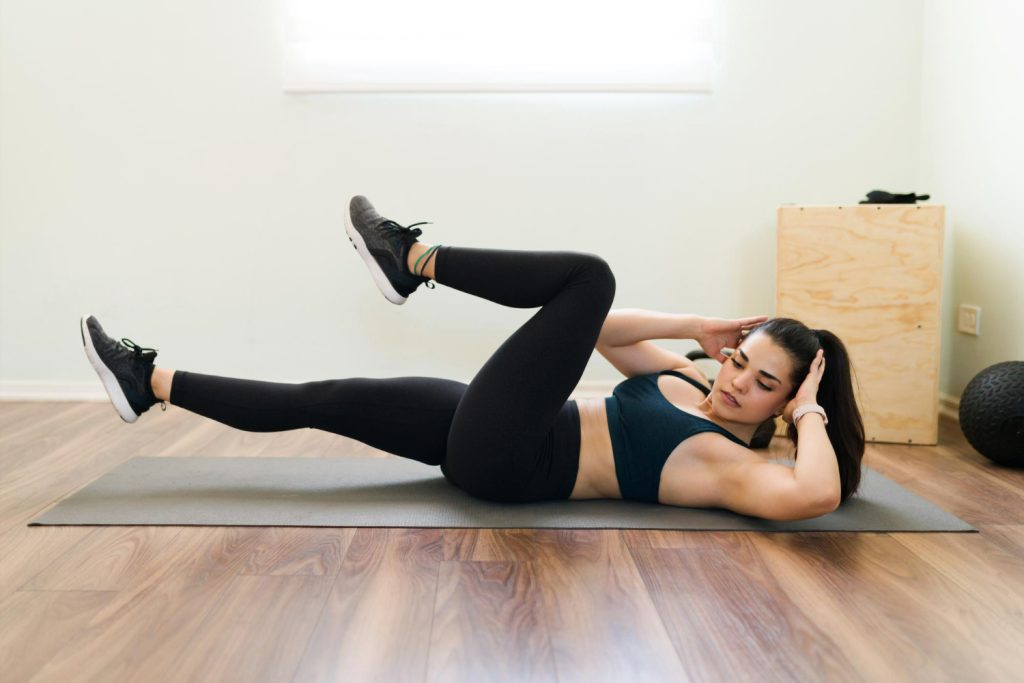In today’s fast-paced world, prioritizing fitness and wellness has become more crucial. Surveys reveal that 40% of individuals consider their well-being a top priority. However, despite this awareness, the World Health Organization reports that many people fail to meet the recommended amount of physical activity.
Establishing a consistent fitness routine is paramount for overall health and vitality. And when it comes to core strength and abdominal development, kick-down crunches are an exercise that holds great significance. This guide will delve into the world of kick-down crunches, exploring their benefits and how they can contribute to an effective fitness regimen. Get ready to unlock the potential of your core and embark on a journey toward a stronger and healthier you.

What Are Kick Down Crunches?
Kick-down crunches are an effective abdominal exercise designed to target the lower abs and obliques. This exercise is a variation of traditional crunches, adding an extra twist to intensify the engagement of these muscle groups.
What sets kick-down crunches apart from traditional crunches is the addition of a “kick” motion. As you reach the top of the crunch, extend your legs outwards in a controlled manner, resembling a kicking movement. This action engages the lower abs and obliques even more, increasing the challenge and effectiveness of the exercise.
Incorporating kick-down crunches into your fitness routine improves core stability, enhances overall abdominal strength, and contributes to a toned and defined midsection. Remember to maintain proper form, control your movements, and gradually increase the intensity to maximize the benefits of kick-down crunches.
How To Perform Kick Down Crunches?
Performing kick-down crunches correctly is essential to maximize their effectiveness. Follow these step-by-step instructions for proper execution:
- Start by lying on your back on a comfortable exercise mat or floor. Please lower your body by bending your knees and ensure that your feet are flat on the ground, positioned at the width of your hips. Place your hands behind your head, lightly supporting your neck, or extend them alongside your body for stability.
- Take a deep breath in to prepare. As you exhale, engage your core muscles by pulling your belly button towards your spine.
- Slowly lift your head, neck, and shoulders off the ground, initiating the crunch. Simultaneously, lift your feet off the ground, bending your knees towards your chest.
- As you reach the top of the crunch, extend your legs outwards in a controlled manner, resembling a kicking motion. Keep your core engaged and maintain a slight bend in your knees throughout the movement.
- Pause briefly at the extended position, feeling the tension in your lower abs and obliques.
- In a controlled manner, bring your knees back towards your chest while simultaneously crunching your upper body forward. As you do this, exhale and contract your abdominal muscles.
- Repeat the crunch and kick-down motion for the desired number of repetitions, maintaining a smooth and controlled pace.
Tips for Proper Form
- Keep your lower back pressed against the ground throughout the exercise to prevent excessive strain on your spine.
- Avoid pulling on your neck with your hands. Instead, use your core muscles to lift your upper body.
- Focus on engaging your abs and obliques throughout the movement, squeezing them at the top of the crunch.
- Control your leg movements and avoid swinging or using momentum to perform the kick-down motion.
- Breathe steadily, exhaling as you crunch, kick down, and inhale as you return to the starting position.
Benefits Of Kick Down Crunches
Incorporating kick-down crunches into your workout routine offers several benefits that target the lower abdominal muscles and enhance core stability. Here are the key advantages of this exercise:
- Stronger Lower Abdominal Muscles: Kick-down crunches specifically target the lower abdominal muscles, including the rectus abdominis and transverse abdominis. By performing this exercise, you can strengthen and tone these muscles, leading to a firmer and more defined lower ab.
- Improved Core Stability: Kick-down crunches engage the lower abs and the entire core musculature, including the obliques and deeper stabilizing muscles. This exercise helps enhance core stability, which is vital for maintaining proper posture, balance, and overall strength during various physical activities and daily movements.
- Enhanced Flexibility: The kicking motion involved in kick-down crunches promotes improved flexibility in the lower body, particularly in the hip flexors and hamstrings. As you extend your legs during the exercise, you stretch these muscle groups, leading to increased flexibility over time.
- Increased Abdominal Endurance: You can develop greater abdominal endurance by consistently performing kick-down crunches. This endurance benefits your core strength and improves your overall athletic performance in other exercises and activities.
- Versatility and Progression: Kick-down crunches offer versatility in terms of difficulty and progression. You can adjust the intensity by modifying the angle of your legs, increasing the number of repetitions, or incorporating additional resistance, such as ankle weights. This adaptability allows you to continually challenge your core muscles and avoid plateaus in your fitness journey.
- Time Efficiency: Kick-down crunches target multiple muscle groups simultaneously, making them a time-efficient exercise option. With this exercise, you can effectively work your lower abs and core relatively quickly.
Common Mistakes To Avoid While Doing Kick-Down Crunches
While performing kick-down crunches, you must be aware of common mistakes that can hinder your progress and increase the risk of injury. Below are some errors to avoid and guidance on how to correct them:
- Using Momentum: One common mistake is relying on momentum rather than engaging the targeted muscles. Avoid swinging your legs or using excessive force to kick down. Instead, focus on controlled movements and use your abdominal muscles to initiate and control the motion.
- Poor Neck Support: Improper neck support can strain the neck and result in discomfort. Avoid pulling on your neck with your hands during the crunch. Instead, place your hands lightly behind your head for support, keeping your elbows wide. Alternatively, you can extend your arms alongside your body.
- Arching the Lower Back: Maintaining a neutral spine position is crucial for proper form and to prevent excessive strain on the lower back. Avoid arching your lower back off the ground during the exercise. Keep your lower back pressed against the floor throughout the movement by engaging your core muscles and maintaining proper alignment.
- Neglecting Proper Breathing: Breathing plays a significant role in executing kick-down crunches effectively. Some individuals hold their breath or forget to exhale during the most challenging part of the exercise. Remember to exhale as you crunch and kick down, and inhale as you return to the starting position. This helps engage the core and promotes better stability.
- Overdoing the Range of Motion: While it’s important to fully extend the legs during the kicking motion, avoid hyperextending or locking your knees. Maintain a slight bend in your knees throughout the exercise to reduce stress on the joints and focus on engaging the targeted muscles effectively.
- Lack of Core Engagement: Proper engagement of the core muscles is crucial for the effectiveness of kick-down crunches. Ensure that you activate your abdominal muscles, especially the lower abs and obliques, throughout the entire movement. This will help maximize the benefits and protect your lower back.
Incorporating kick-down crunches into your exercise regimen can yield numerous benefits, including stronger lower abs, enhanced core stability, and improved flexibility. By avoiding common mistakes and focusing on proper form, you can unlock the potential of this exercise and achieve a stronger core, taking your fitness journey to new heights. Embrace the power of kick-down crunches and pave the way for a stronger, fitter, and healthier you.

Frequently Asked Questions
How do Kick Down Crunches differ from traditional crunches?
Kick Down Crunches differ from traditional crunches by incorporating a kicking motion, targeting the lower abs and obliques for a more intense workout.
What muscles do Kick Down Crunches target?
Kick Down Crunches primarily target the lower abs and obliques while engaging the entire core musculature for improved strength and stability.
Can Kick Down Crunches help with strengthening the core?
Yes, Kick Down Crunches are excellent for strengthening the core as they engage and activate the abdominal muscles, leading to increased core strength and stability.
How many sets should be performed during a Kick Down Crunches workout?
It is recommended to perform Kick Down Crunches in sets of 3 to 4, with 10 to 15 repetitions per set, allowing for proper rest and recovery between sets.
Are there any variations of Kick Down Crunches for beginners?
For beginners, modifications can be made by performing the exercise with bent knees, reducing the range of motion, or gradually starting with fewer repetitions to build strength and endurance.







